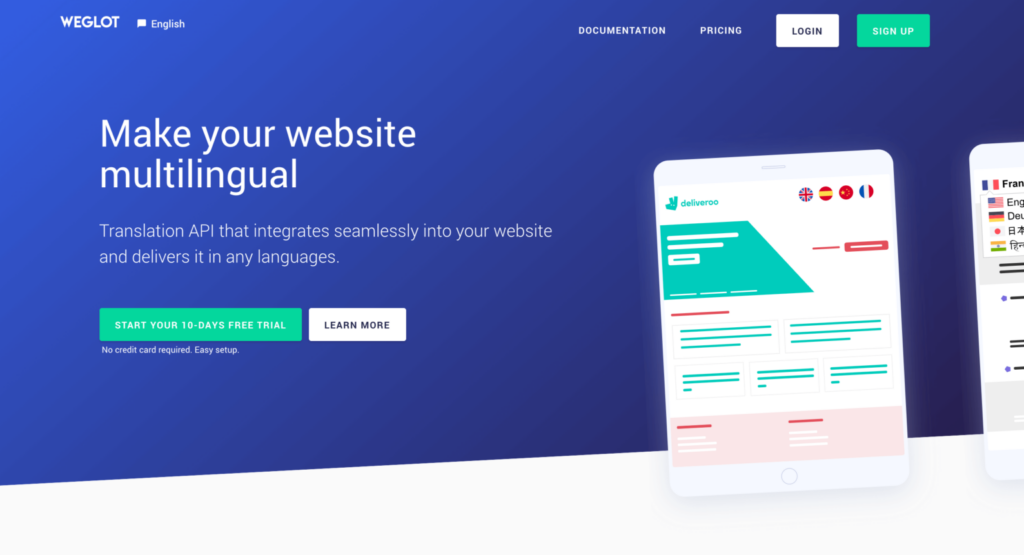
Introduction to Multilingual Websites and SEO
There are a number of benefits to translating your website’s text. For instance, it increases your potential audience, can help increase your conversions, and it even offers a boost to your site’s accessibility. However, those are far from the only advantages offered by a multilingual site.
One often overlooked benefit of making your site available in multiple languages is that it can help improve your Search Engine Optimization (SEO) efforts. This requires you to structure your multilingual site correctly, and make sure you have the right tool for creating the multilingual content in the first place.
In this article, we’ll discuss how you could improve your SEO by making your site multilingual. We’ll also show you how a WordPress multilingual plugin such as Weglot can help you make it a reality on your site. Let’s get started!
The General Benefits of Translating Your Site
If your site uses English as the primary language, it’s part of an enormous majority. In fact, over half of all websites provides its content in English, which makes it by far the most common language online. That’s perhaps not shocking, as English is also the language that most internet users speak. However, those statistics are still somewhat surprising compared to the rest of the world.
For example, while nearly a billion internet users speak Chinese, it’s not represented by even 2% of all websites. Similarly, under 5% of websites offer Spanish, even though over 500 million users speak the language. It seems many site owners have simply decided to focus on the most popular language among users, and subsequently skipped over the vast numbers who don’t otherwise speak English.
This may not seem important at first glance – after all, half the internet is a large number. However, there are plenty of benefits to stepping outside of this narrow mindset. For example, translating your site can help you:
Expand Your Potential Audience – By translating your site, you’re inviting millions of new visitors who speak languages other than English. This move taps into vast, relatively untapped markets worldwide, significantly enlarging your potential audience well beyond the 25.9% of internet users who are English speakers.
Communicate with a Diverse Group of Users – Localizing your content goes beyond mere translation; it involves adapting your site to the cultural nuances of your target audience. This creates a trust-based relationship, as users feel understood and respected, setting your site apart from competitors and fostering customer loyalty.
Increase Your Conversions – People prefer to shop in their native language. Providing content in users’ native languages reduces confusion and builds confidence, making them more likely to complete a purchase. It signals that you value their user experience and are committed to meeting their needs.
Empower Global Reach and Cultural Connection – Offering multilingual content doesn’t just broaden your audience; it also enriches your site with cultural diversity, fostering international understanding and inclusivity. This not only enhances your brand’s global appeal but also positions you as a participant in the global conversation, appealing to a broader, more socially conscious consumer base.
In essence, making your website multilingual isn’t just a strategy for growth—it’s a commitment to inclusivity, understanding, and respect. It reflects an awareness of the global nature of the internet and a dedication to making the web a more accessible place for everyone, regardless of language. This approach not only benefits your business but also contributes positively to the broader digital ecosystem.
In addition, making your site multilingual could actually also help it rank better in search engines. Let’s take a look at why this is.
How Making Your Site Multilingual Could Improve Your SEO
Search Engine Optimization (SEO) is a crucial process for ensuring your site is visible in Search Engine Results Pages (SERPs). The better your site ranks, the higher your pages will appear for relevant search keywords.
As we said, you can actually improve your SEO simply by making your site available in multiple languages. We’re going to look at the main reasons why right now!
Translated Versions of Your Site Improve Its Overall SEO Rank
The easiest way to understand this is by looking at a real-world example. Imagine example.com was available in English and French, and that each translated version of the site had its own unique URL. For example, you could use a different domain name for each, such as using example.fr for the French version. Alternatively, you could use a subdomain or subdirectory, such as example.com/en/ and example.com/fr/.
Either way, search engines will read both versions as parts of the same site. This means any traffic you get from either version will improve the search engine ranking for the whole site. It also helps search engines understand your site, as it’s clear which languages you’re providing the content in.
In order for this to work, you naturally need to avoid a translation solution that places all languages on the same page, or uses a # symbol in your address or cookies to determine the language. These methods will negate the SEO boost that a multilingual site can offer, so make sure you structure your translated versions correctly as per Google’s multilingual SEO best practices.
You Can Target Specific Regions More Precisely
While a multilingual site will enable you to reach an international audience, you should still understand exactly which people you want to target. One important aspect of this is performing keyword research for the languages you intend to use. If you’re using Google Analytics, you could even target high-traffic regions.
Once you know which countries and languages to aim for, you can create a translated version of that site, then perform your standard SEO practices. You can also use a process called ‘geo targeting’ to reach them better, as this lets you target specific geographical locations.
In order to get the most out of your work, you should also aim to create a multilingual SEO strategy. This will help to ensure users from the locations you want actually find the right version of your site. For example, it’s not much use to translate your site into German if those within the country see the Spanish version instead.
More Visitors and Engagement Means Better Ranking
This last point may seem obvious, but it’s worth mentioning as ultimately one of the key factors in any successful SEO strategy. Put simply, search engines value quality content and user engagement. If you manage to provide content that drives traffic, Google will notice and rank your site higher as a result. If you provide content in various languages, driving traffic from specific locations all around the world, it will also be noticed.
As such, simply ensuring your site provides value to your visitors, regardless of language, will help you see results. Fortunately, Google provides a lot of information on how you should structure your multilingual sites in order to achieve the best results.
How to Translate Your WordPress Site
The Weglot Translate home page.

While there are plenty of benefits to running a multilingual site, actually creating one can mean a substantial amount of work. Fortunately, if you have a WordPress multilingual plugin to hand, it won’t be nearly as time-consuming or difficult. Weglot Translate is such a plugin, which enables you to automatically generate a translated version of your site into any of over 100 languages.
Weglot is a complete translation solution, in that it works with every aspect of WordPress, and is optimized to improve your SEO ranking. This is because Weglot produces new versions of each translated page, and automatically applies Google’s SEO multilingual best practices.
It’ll even translate text produced by plugins such as WooCommerce. You can also use the Weglot dashboard to edit your translations, which lets you ensure your content is spot-on, regardless of the language. The intuitive nature of such tools simplifies the process, breaking down language barriers with a few clicks and ensuring your content resonates with a global audience. You can get started with Weglot for free and they offer a 10-day trial.
Conclusion
Providing your site’s content in multiple languages helps you grow your potential audience and increase your conversions. In fact, if implemented correctly, it can also improve your site’s overall SEO ranking. If you have the right translation tool, you won’t even need to know a second language yourself to do it.
In this article, we’ve discussed the following reasons why translating your site using a WordPress multilingual plugin such as Weglot could improve your SEO:
- Translated versions of your site improve its overall SEO rank.
- You can target specific regions more precisely.
- More visitors and engagement means better ranking.
Remember, the internet is a global village. By making your site multilingual, you’re not just optimizing for search engines; you’re opening your digital doors to a world of diverse cultures and languages, creating a richer, more inclusive web experience.

Hey John,
If i use two language on my website like Hindi and English then we need to write content in both language or not ? Can this plugin automatically convert the words in other language ?